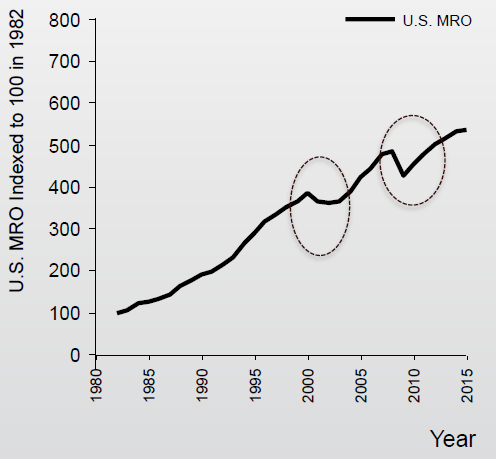W.W. Grainger (GWW) is a time-tested business that has rewarded investors with 44 consecutive years of dividend increases. Like many other industrial companies, weak energy markets, sluggish growth in China, and foreign currency headwinds are challenging GWW’s current business trends.
As a result, the stock’s dividend yield sits at 2.4%, which is well above its five-year average dividend yield of 1.5%. With a sturdy business model, healthy free cash flow generation, and decent long-term growth potential, GWW is a dividend growth stock we are watching for our Top 20 Dividend Stocks portfolio.
Business Overview
GWW was founded in 1927 and is a leading distributor of maintenance, repair, and operating (MRO) products that include motors, lab supplies, power transmission, test instruments, outdoor equipment, safety products, power tools, and janitorial supplies. More than 4,500 manufacturers supply GWW with 1.4 million products made available to customers through GWW’s branches and distribution centers. The average customer invoice for GWW’s products is about $250, and customers place orders over the phone, at local branches, online (36% of sales), and using mobile devices.
The company has over 1.4 million customers in the U.S. (78% of sales) and meaningful operations also in Canada (10%), Japan, and Western Europe.
Its customers represent a broad collection of categories including heavy manufacturing (18% of sales), commercial construction (14%), government (13%), contractors (11%), light manufacturing (11%), retail/wholesale (6%), transportation (6%), natural resources (5%), and more.
Business Analysis
GWW operates in extremely large, fragmented markets. According to a company presentation, GWW pegs the North American MRO market at $150 billion and the worldwide market at $545 billion. As seen below, the U.S. MRO market has also steadily grown in value over the last three decades.

Source: GWW Investor Presentation
As we mentioned, the MRO market is very fragmented. GWW provided the following image in its 2015 Fact Book. It shows that GWW has the largest market share in North America at just 6%, and the other 10 largest distributors collectively hold about 26% market share.

Source: GWW Fact Books
Understand why the MRO market is so fragmented is the key to understanding GWW’s competitive advantages. GWW mostly serves large customers, and these businesses require a wide range of products that they need delivered quickly and cost effectively.
With the largest network of distribution centers and store branches (over 680) in the country, GWW is strategically positioned with localized inventory that is close to its most important customers. Being in close proximity to customers helps GWW deliver products to them very quickly, offer a high quality of service, and keep costs low. Competitors would need to acquire properties in the same service area to compete with GWW, but they wouldn’t have the established book of business to cover all of their costs. The mature state of the MRO market makes it very difficult for new players to crack into a geography already covered by a capable distributor, somewhat limiting competition.
GWW’s scale and inventory assortment are also advantages, especially in the large customer market. As the largest player in North America, GWW has somewhat better purchasing power than local or regional distributors. This allows it to offer very competitive pricing for its products, which are generally undifferentiated from one distributor to the next.










Leave A Comment